We are interested in learning more about your idea and have found face-to-face meetings (either in person or via video conferencing) are the best way to do so.
It’s critical for us to know which phase you are at in order to suggest the best solution for you. Our goal is to make sure we are the right team to equip you with all you need to “win” the game. And if we are not, we may advise you to other solutions that may be better for you at the stage you are at.
After learning about your idea, we provide a brief overview about us and our value props. We’ll guide you though the phases of our process (from getting funding to maintenance and continuous development.)
After the meeting we send you a recap or our conversation and make suggestions on how we could help you.
Well, if you bought a $1,000 coat at a famous 5th Avenue retail store and lost it and then found the same exact coat was being sold off the back of a truck, would you pay the same $1,000 for it?
It may be the same coat but it has a much lesser perceived value because of the different buying experience. If you want big bucks from VCs and adaption by the masses, you need to maximize your perceived value right up front.
We partner with the team at Lúgh Studio on brand identity to ensure that your brand identity is in alignment with the awesome marketplace we’ll build you.
In order to have a brand, you need to have a clear vision of who you are and who you want to grow into being. These are critical to know before building your business regardless. So the process we take you through in building the brand can help further hone your message and direction.
If you don't do your brand at the start and wait until later then you have to back track to any and all public-facing materials, websites, business cards, stationery, marketing collateral, etc. and in some cases it can make sense to spend a bit more later.
We will deliver your logo in multiple formats for both digital and print. Additionally we will supply you with a brand guideline. This should be a living document that grows as with your company as you add more and more collateral materials. The launch guideline will include palettes as well as instructions for collateral materials such as business cards, email signatures, email templates, use of logo on web and in print (the do's and don't's), etc.
If you don't have a brand and are not able to invest in one yet, then we can use just your name in text until you are ready to invest in a brand. By using basic clear text you're not going to confuse an investor in thinking this is your brand. It will be clear that you have not made that investment yet. This is better than "winging" it with your cousin's nephew who's "good at drawing" because if you go that route this will be your brand and that will be what you are telling the world who you are.
A successful start-up website about selling your product to your early customers and potential investors. It should have the following.
Look good: Users make judgments about the credibility of a startup based on how the site looks. They tend to forgive early product mistakes or luck of functionality if they made right.
Tailor made: Your product is not for everyone, nor is your site. It should speak the languuage of your customers. If you sell services to layers it will need to have longer, more detailed descriptions whereas if you have a sneaker marketplace, it's better to use emojis and slang.
A quick tour/demo: Let visitors know what your product does easily and quickly through a simple video or product demo. We can excite users to show them how your marketplace will look and start getting their feedback. Before it's even built!
Some of the most successful marketplaces built significant traction before launch. You need to start collecting inventory though emails or pre-registering users, which is especially important in making a compeling case to investors.
Have a great marketplace idea with minimally viable product, but not quite ready to go full-speed ahead with a startup website or sales machine? We might have the solution for you.
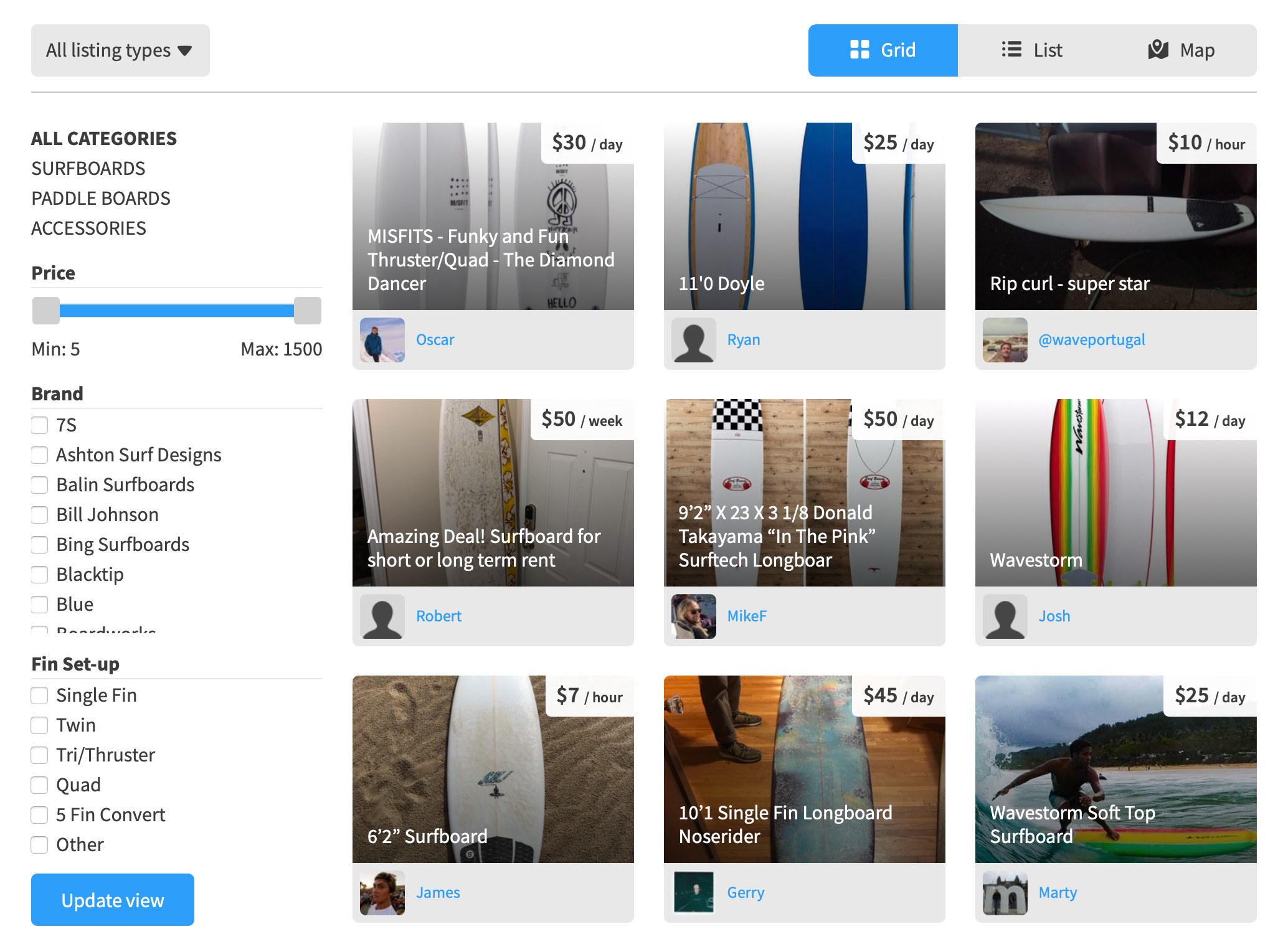
Sharetribe is a pre-built online marketplace platform, offering a wide range of services for most marketplace types. Sharetribe supports and provides you with all the services you need to flush out your idea in the early stages of its development. With built-in booking/rental, payment and marketplace management systems, creating and managing your MVP marketplace has never been easier.
We recommend trying Sharetribe in the scenario that you lack adequate funding for full-stream website development or still need sufficient testing and performance results to be able to pitch to investors.
And if we are not, we can find other solutions that may be better for you at the stage you are at.
What we do is to build you a user aquisition vehicle before the product is even built. This way you can start preparing for your launch and make a compelling argument to investors. We will learn about your industry and see how we can get you your early customers.?
We start by creating a base to support your sale machine. We put together infrastructure to support it. We start setting up a multi-user CRM and figuring out your sales funnel.
Depending on your marketplace type, we continue by building a database of potential customers, cold leads, and connect your CRM to Mailchimp for automated marketing drip campaigns.
Next we create Facebook and Linkedin ad accounts and run ads to see how well they work for your industry and calculate what is your customer acquisition cost.
Finally, we cross-integrate everything with Goolge Analtycs reports so you know all your key numbers and can present it to investors.
Getting someone to write you a check is a tall order. The more prepared you are the more likely you can raise investment. We put together a package designed to maximize your chances of getting funded. Our services are structured such that we can learn about your business and figure out that right combination of services so you "win."
Combined with a impressive presentation, a pitch deck is essential for successful fundraising. A great idea (or budding startup) with a sloppy presentation or pitch that leaves key questions unanswered has little to no chance of persuading investors to part with their dollars.
When it comes to pitching, competition is intense. Startups use all the ammunition they have – number of users, monthly growth, revenue, feature concepts, prototypes, MVPs, usage feedback, and anything else that will help prove their case. The best pitch decks provide an organized presentation that allows the founders to perfect the right arguments, in the right order, with the right visual tools to create the maximum effect.
Less is more. VCs skim your deck. You need to have an effective message gets their attention enough to want to go deeper. A pitch deck isn't something that's just tossed together in a rush, it's a distillation of a lot of information. The best slide decks are a mix of science, persuasion and art – using each slide as another stroke of paint on the canvas.
Because we've worked with tons of investors and know what they are looking for we can help to make you that deck that really works.
Investors are busy people. Even with the best idea and deck it still is not easy to get their attention. Average investors receive over 100 decks a day and spend less then 30 seconds going through each one.
If you're personally talking to potential high-net worth investors for whom you have an introduction, you probably don’t need a video. On the other hand, if your initial contact with a potential investor is online, then a video can give you an advantage in being seen. If your dealing with an organized group of angel investors, it is even more important.
The reason for this is that, despite protests to the contrary, angel investors, to a large extent, react on a somewhat intuitive basis. Their in the entrepreneur personally is one of the most important factors in their decision process. And whether it's true or not, most people will tell you that they can tell much more about a person from seeing them speak as opposed to a written communication.
So when reviewing 20, 50 or 100 submissions for funding during the screening process, it's incredibly helpful for a VC to be able to watch a quick (1-2 minute) video elevator pitch to get an instant gut feel for the entrepreneur and the company. It's the same clues they look for during an in-person meeting.
Most investors will ask for your 5-year projections as part of your submissions. Some startups just make it up and this is a great way to get your submission declined. Many entrepreneurs present unrealistic revenue and customer acquisition expectations or grossly underestimate real expenses. The art is to figure out how to get to the numbers that VCs feel that it it realistic for them to expect to show that your opportunity can provide the level of return they require. For example, it's expected that year 5 ARR would be between $20 and $500M, CAC > LTV at least 3 times, YoY at least 5 times, user retention over 80%, etc, etc. And if you don't know those terms now, you will.
Its critical to demonstrate realistics level of tech and marketing expenses that are proportional to the revenue and realistic plan for the exit. We work with you to help you put together all those numbers in industry understood format
Over the years we have manually researched direct contacts of main US-based VC firms and angel investors. This was no easy task as investors are known to hide their email addresses. Once we've completed your marketplace, we can send out email to approximately a thousand VC and angel investors specializing in seed and pre-seed marketplace deals. Typically it gets you some conversations started.
Of course the more you have done, the better but often business plans are full of conjectures most of which have little bases in reality and professional investors know it. Most of the facts they will be interested in can be covered in an executive summary—especially in the seed stage. Later, yes, you will need a full business plan but at the start where every hour, every dollar counts, your resources are better spent on the essentials.
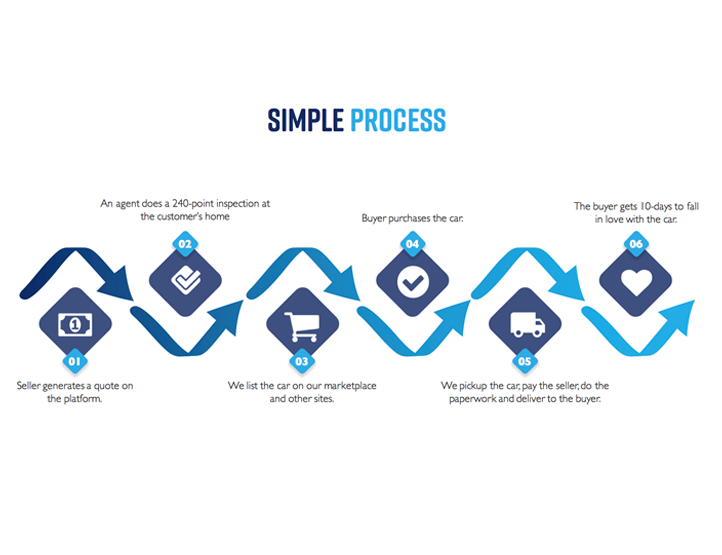
Good research is the most effective way to implement your vision
The critical first stage is research. We research the industry, competitors, unit economy and technological limitations. The result is a plan to execute on the most elegant solution possible to make make your idea into a reality.
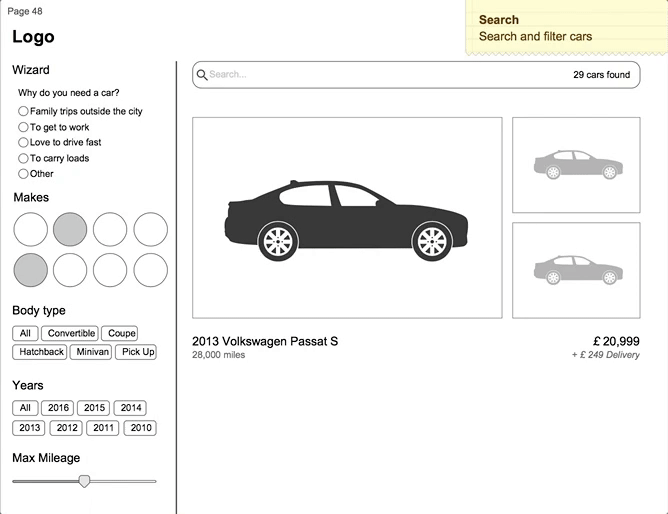
Planning exactly how your application will work
Like building an amazing building, a good marketplace build starts with good wireframing. Wireframes are the architectural and functional layout of what your site will be—like the blueprints of a building. They’re like a skeleton for your marketplace. Yes! every page of the site, every button, every notification email, it all needs to be wireframed and planned in advance.
Website wireframes are 90% thinking/planning and 10% drawing.
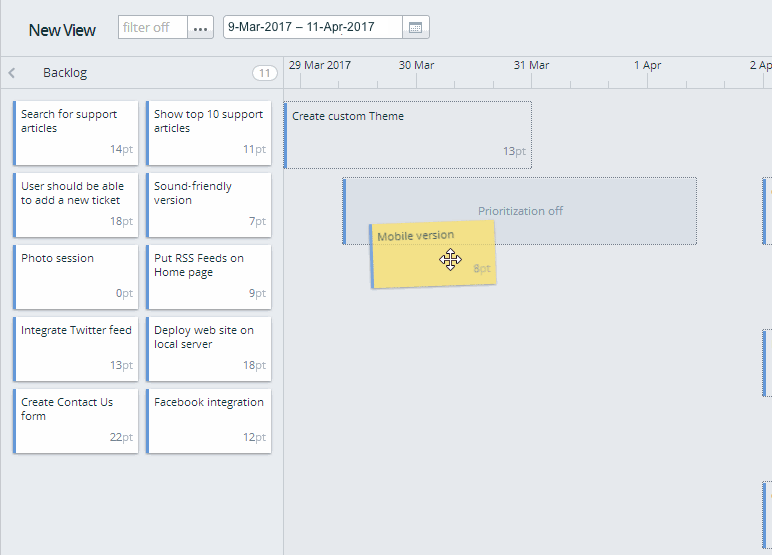
Determining resources and timeline
Having done the research which allowed us to strategize exactly what needs to be built and how, now we have the information we need to allocate resource to accomplish the goal. Because our wireframes are so granular and thorough, we are able to commit to a Fixed Cost and development timeline.
We start by listening to your overall idea and then move to understand all the details. We do multiple meetings both internally and with you. Your feedback is critical to the process. Additionally, we learn about your expertise, your market research, and make sure that we understand how you see the marketplace functioning. We will ask you questions you most likely never thought about. If you are going for funding, you'll see at the end of the process that you are "fluent" in your concept. They will be able to throw any question at you and you will be able to easily answer it.
For example, for the legal cannabis marketplace, we asked which banks he researched that could process cannabis payments, how packages will be delivered and how those delivery people will be paid. How returns are handled and how geo-fencing needed to be used. For the pre-owned car marketplace, we had to learn about the "Driver and Vehicle Licensing Agency" (our equivalent to the DMV).
Every marketplace has very specific and unique needs.
We make sure we know them well up front.
We research the industry and try to gain as much knowledge as possible. Typically we check competitors sites, make sample orders or bookings, research similar apps, governments regulations, store's policies

For example, when we was working on sporting good marketplace for manufacturers shipping directly from China we had to research China's specific payout method - AliPay and specific shipping providers only available in China.
We created merchant accounts with other similar marketplaces and made few sample orders to study workflow of best players in the industry
We research databases & APIs that are specific to your idea and market to determine what data & services we can use and how.
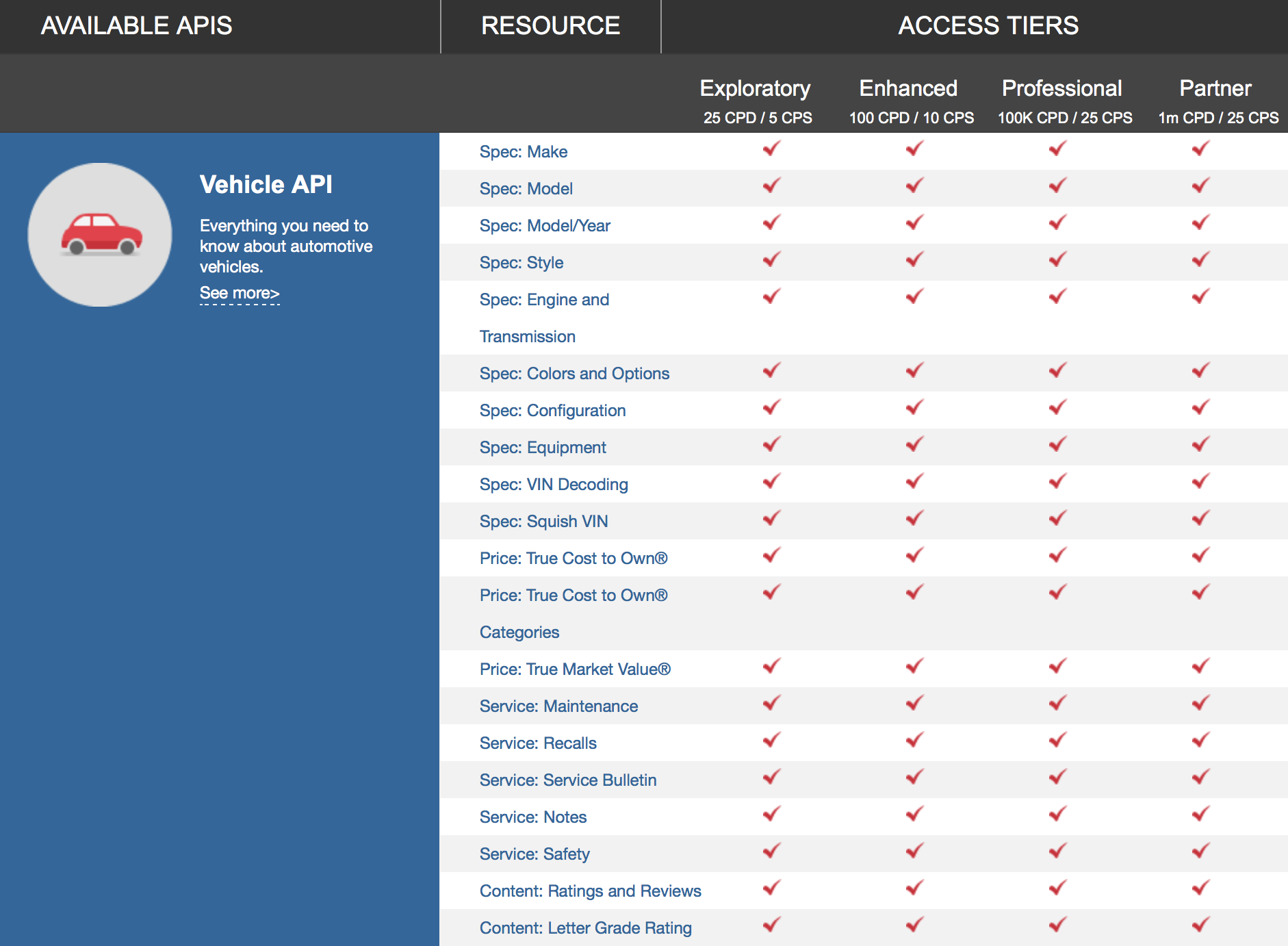
For example, to build the preowned car marketplace in UK, we researched several APIs to understand what data was available to use and if we would be able to price cars algorithmically. We investigated on the what would be the best method to create panoramic pictures so buyers would be more confident in their purchase.
Key to coming up with the most elegant solution possible is challenging every assumption. We search out the weak points in the concept so that we can find solutions. We delve deeper into the unit economy, business, and technological risks to see how we might be able to lower development cost. It is all about being as efficient, targeted, and impactful as possible.
For example, a client came to us to build a marketplace for donations on mobile devices. Sounds like a straight-forward simple idea. But because we challenge that assumption that is it that simple, we discovered in our research that Apple has a specific policy around such apps and they require a specific architecture for them. Had we not done the deep dive, we would had "assumed" that it was like any other iOS app and the app would have gotten denied. We would have then had to rebuild the core functionality of the app adding not only more time before launch but also significantly more expense.
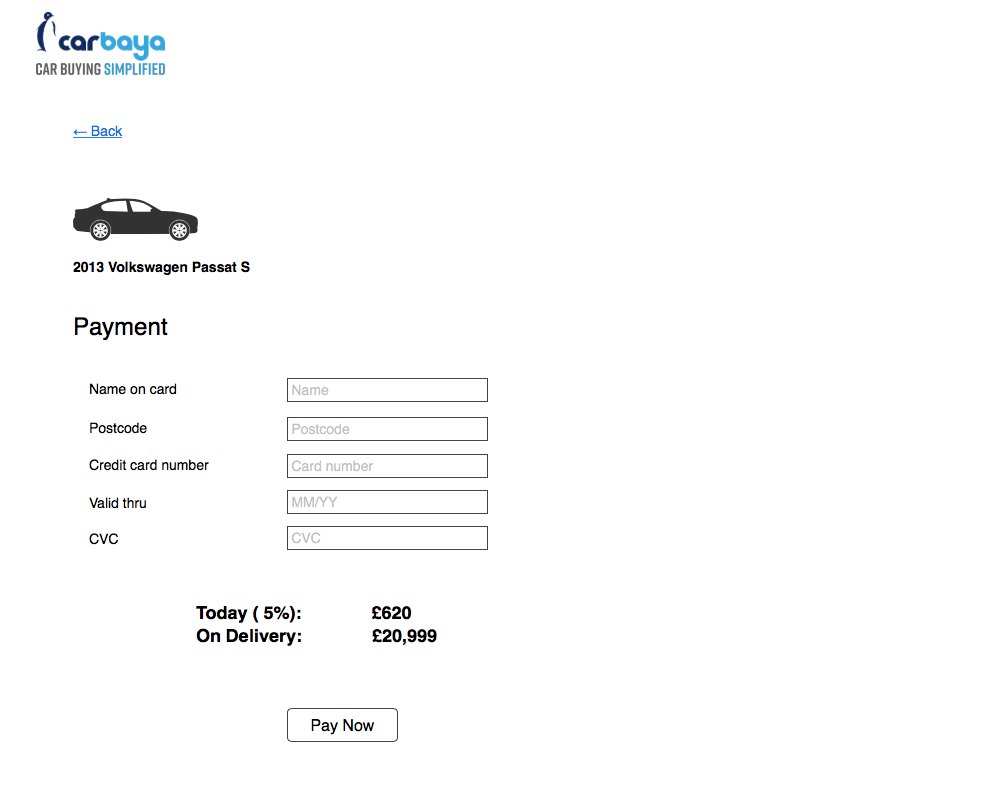
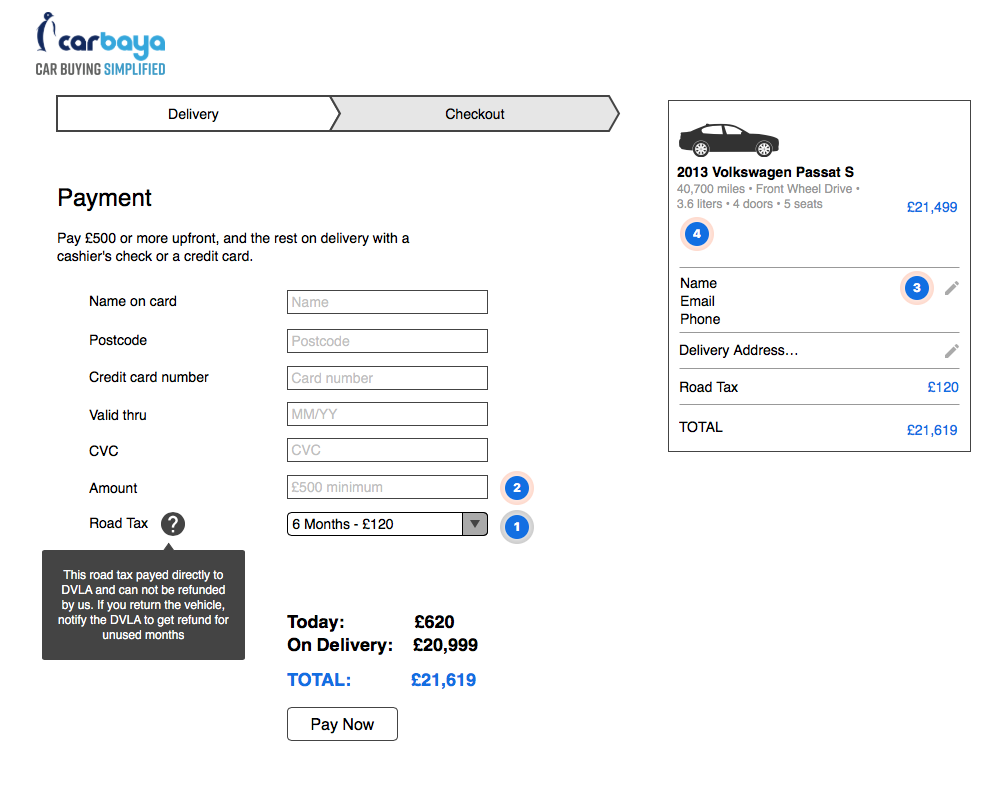
We work with you to decide that are the key, core functionalities the system must have a launch and what can be phased in later. We do this for a couple of reasons. First, we can imagine all sorts of scenarios where this or that extra functionality would be “great to have” but it’s not until you are getting real user feedback that you can be sure if they will even use it.
Second, budget. Typically, when building a marketplace, you are using precious early dollars. An extra $50K 5 years from now will hopefully be a rounding error for you but today it is a big deal. We respect that.
A better approach is to go deep and more narrow and be sure that what we build is kick-ass good. Get real user feedback and then invest in building out beyond that based on real data. That’s best use of your resources.
So to make sure we hit the mark, we dive in and develop detailed workflows for each functionality. We use real data examples and simulate complex scenarios with hundreds of thousands of users.
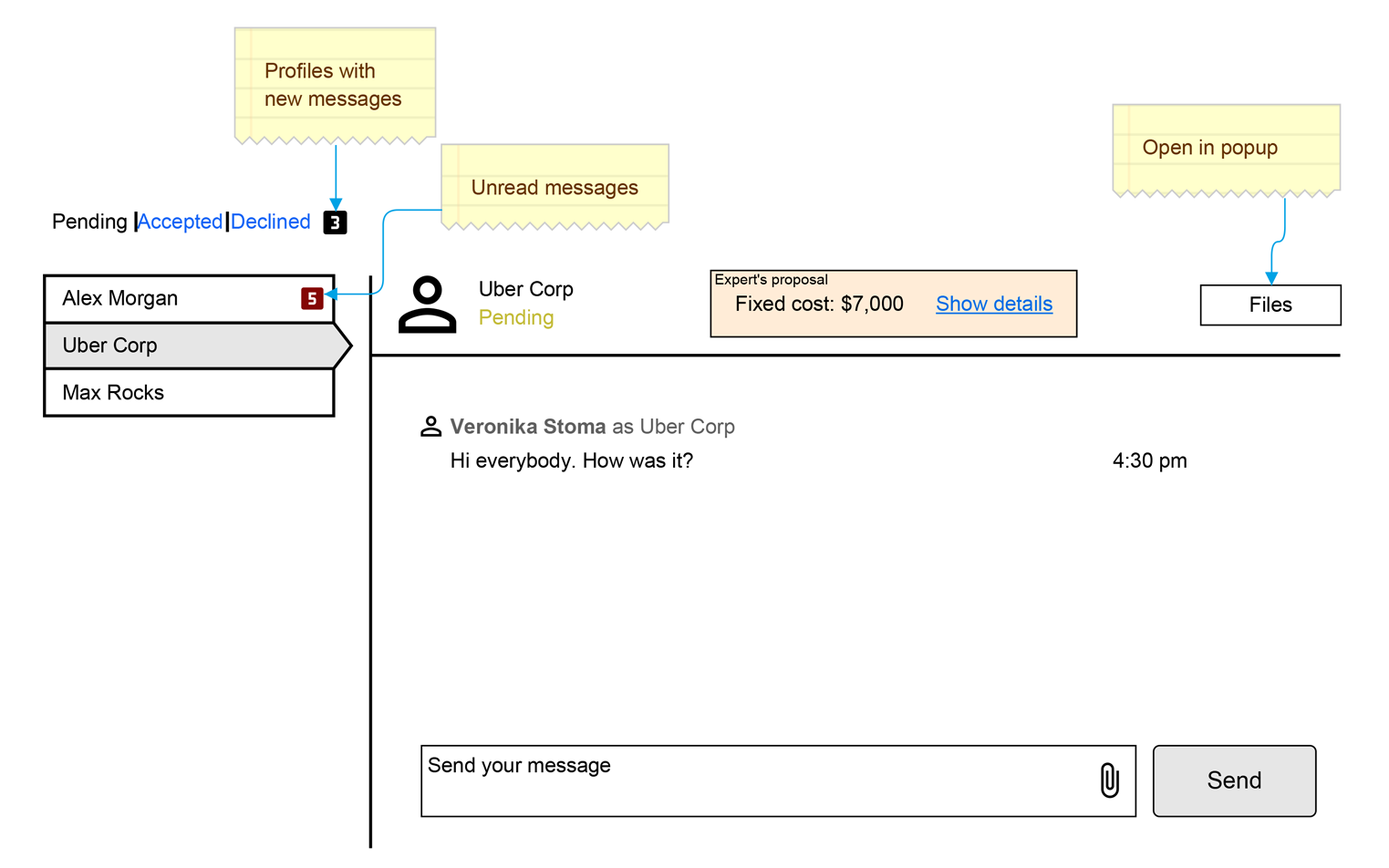
If you think about it, it makes sense that everyone has become a much more particular user. People are not willing to forgive you for having a half-baked mediocre experience. And if you have any doubt that is true, take a look at how many apps you have downloaded to your phone you never use. Why? They didn’t “suck” or you would have deleted them. They were simply… meh. You cannot afford to have your users consider you “meh” or they are gone forever.
So to make sure we hit the mark, we dive in and develop detailed workflows for each functionality. We use real data examples and simulate complex scenarios with hundreds of thousands of users.
We figure out what the best user experience using these functionalities will be. We optimize the experience for various devices and a produce skeletal framework (blueprint) in the form of web-based clickthrough wireframe. This wireframe depicts each page’s layout and the entire arrangement of the entire marketplace’s content including interface elements and navigational systems. And it demonstrates how all of this will work together.
The result is a 100-200 page click-though mapping out the entire user and administrator experience. You get a precise engineering plan & the blueprints for the building the product. Because it is so granular, we are able to then commit to a fixed price to build the marketplace.
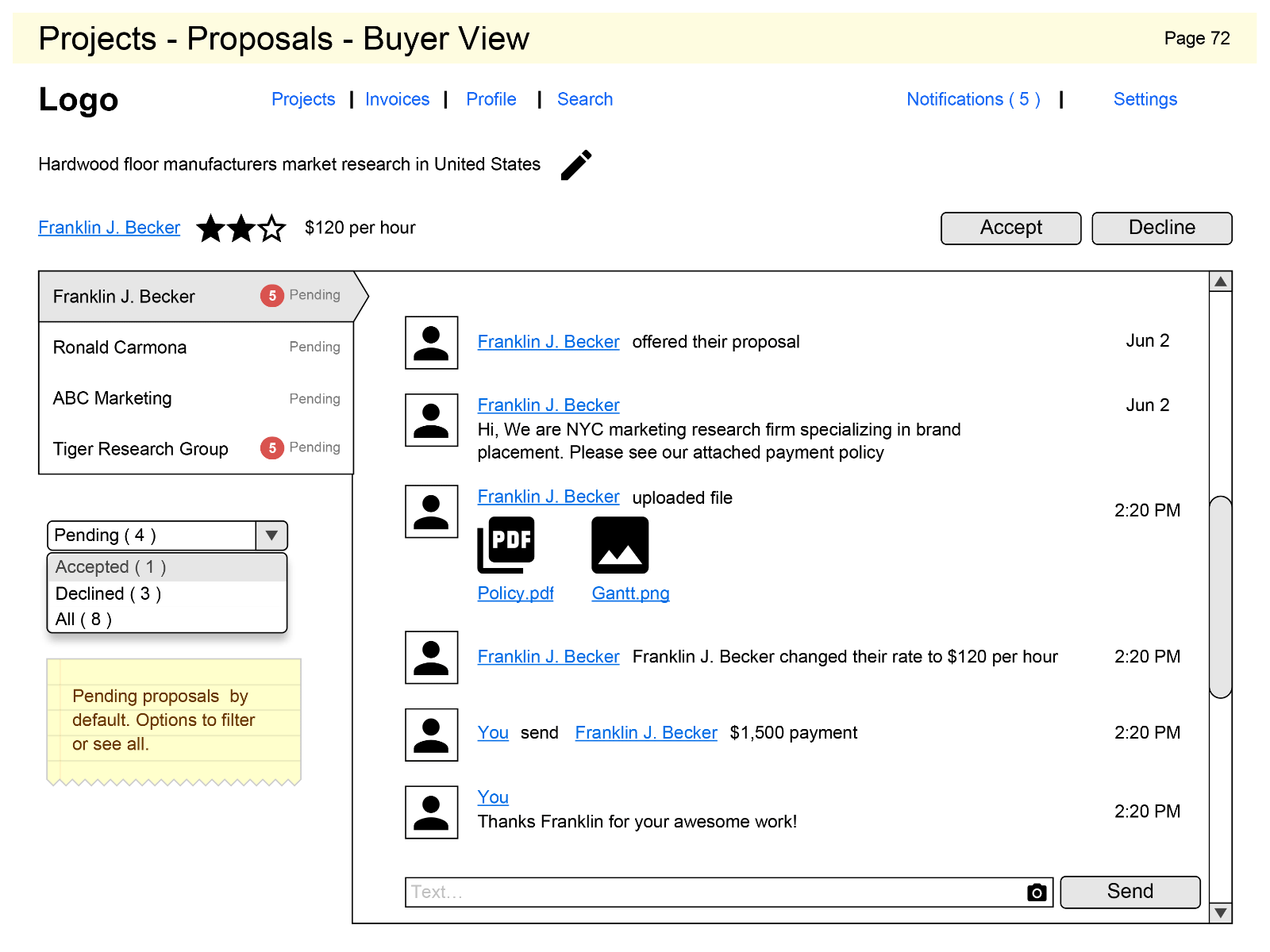
We breakout the resulting wireframe into bi-weekly deliverables so you can see when each functionality will be developed and can provide your feedback early in the process. We calculate how many hours will be needed for each deliverable so that we can efficiently allocate the needed resources to deliver on the deadline.
Only now, after we understand every tiny detail about your project, are we able to provide you with final fixed cost and guaranteed development time.
Based on this final fixed cost and lead time, we create a payment schedule that allows you to have predictable spending and plan your budget ahead.
After you've completed the product architecture phase and have your main wireframes — the real fun begins. This is the final phase before we start actual development and is as close to a real product as it can possibly get.
We work with a team of designers under an art director's supervision and a software architect to make another iteration of your product based on the previously developed wireframe, only now with the focus on actual page and email content, UX flow, and final look and feel.
During this phase we often discover some additional missing screens, discover better interfaces or re-think some of the flows. The final deliverable is a Figma project and PDF where each page is laid out.
A typical marketplace can have over 300 screens.
Now when you go to your investors, not only do you know how long and what the cost will be to build your marketplace, you know what it will look and feel like as well. It's becoming so real you can taste it!
No single developer, as great as they may be, can do complex marketplaces. It is simply just too much for one person. We have a SWAT team consisting of a software architect, an art director, designers, backend and frontend developers, QA team to work exclusively on your project. We put into each build over 100 years of combined experience. Everyone on the team is very efficient because they have mastered marketplaces. Think Oceans 11.
During this phase we do ground-up marketplace build including coding, infrastructure setup for both the staging and production environments, acceptance testing and production launch.
High-quality code is what makes the system easily maintainable and reliable — it doesn't require constant attention. The better the code, the easier to change processes or fix issues. We've created quality, elegant code.
Normally commit to complete initial development within 3-5 months from the mutually agreed start date. However, because we will be learning more information about the industry, because we may need collaboration from your software team or because of unforeseen changes in our team or force majeure we could possibly be off by few weeks. If this happens, we will eat that additional development cost and won’t charge you for the additional time.
Although we do very detailed wireframes and iterate it more during the design phase, some functionalities are likely to change in the development process. Typically a final build is about 90% of what you see on the design as we may need to tweak it as may need to work around an unanticipated obstacle. Other reasons for a possible variance include conceiving better user interfaces or learning new information about the business processes. Some of those changes are likely to come from you and some likely to be initiated by us.
We maintain a staging environment with the most current version of your marketplace for your testing. We typically update the staging server several times a day. We encourage you to test the marketplace as early as is reasonable and provide us with feedback during these early stages.
We normally write a limited number of automated functionality tests using mock objects for some key marketplace flows such as login, inviting team members, accessing search or making a purchase. We recommend to gradually increase the number of such tests based on real time crash reports.
As part of our development process we manually test all deliverables including acceptable staging server and intermediate builds.
We typically complete the major development 2 weeks before the due date. The last two weeks are reserved for bug fixes, minor visual and content changes, minor leftovers, final acceptance testing and preparation for production launch. During this phase you need to conduct your own intense testing of all developed functionalities. During this phase we focus exclusively on bug fixes rather than modifications of existing interfaces and functionalities.
After we complete the development and pass acceptance testing, we do a production launch. The system will also be tested once again in the production environment to ensure everything is working properly. Additionally, we will test deployment and database update processes and issue reporting and monitoring. At this point you can start inviting your beta users.
In addition to automated testing and manually tested releases, we react in real time on crash reports. We monitor the Slack channel where we receive real time notification of code failures and often are able to commit critical hotfixes within an hour.
We have built a company structure that takes advantage of maximum efficiencies. We run a very lean company with minimum overhead. This allows us to offer considerably below-market pricing. The tradeoff is that we do not have the ability to start and stop. Once we start, we need to complete the project. If there is a disruption in payment and we have to let team members go or put them on other projects, it can considerably delay delivery of the marketplace and/or increase the overall build cost.
Therefore, it is important we adhere to the payment schedule agreed upon. Because it takes significant commitment to prepare for complex development we require an non-refundable payment in advanced equivalent of 1 month of work of all allocated resources to start the process. After that, we will send invoices electronically for each next month 7 days before the next cycle begins.
Maintenance is about making sure things work. Maintenance involves checking logs, server, database & infrastructure health, updating servers & security, backups and backup restores, monitoring access and usage, fixing third-party dependencies, fixing issues with browser updates, fixing exotic use cases, scaling to traffic, performance optimization, internal bugs and issues.
Maintenance can range from 20 hours a month for very light usage to a full-time engagement of multiple developers once you have significant operations.
Collaboration is about providing technical direction for the software development team. This includes developing product planning and feature roadmaps, overall day-to-day management, gathering business requirements, architectural discussions and decisions, internal and external meetings, resource planning and workload scheduling.
Collaboration can range from 25 hours a month for very light usage to a full-time engagement once you have significant operations.
Continuous improvement is about iterating and improving the marketplace, reacting to users’ feedback and adding new functionality. The amount of time is based on what is best for your unique business need and this can vary from 50 hours a month to a large amount of hours per month.
Because your goal is to actively grow your product, we recommend a commitment to a combined maintenance, collaboration and continuous improvements monthly package. By having a set amount of hours allocated specifically to your marketplace in advance, we are able to effectively maintain the required resources.
In return, you get predictable monthly spending, fast lead time to issues and change requests, and proactive application and infrastructure health monitoring.
Our regular blended hourly rate is $135 per hour. We offer blocks of hours in increments of 100s at a discounted rate of $100 per hour. The minimum monthly commitment is 200 hours ($20K/month). You have the option of adding more time in 100 hour blocks up to 1,000 hours per month at which point we would negotiate a different support structure specific to your needs.
Although every business has its own unique requirements and usage, we find the following breakdown to work best. Software architect, database architect, PM, designers, frontend developers, devops, copywriters, QA, etc. can be involved in the project as needed part time.
However, because the typical startup backend codebase is so large and complex and because it takes significant time to dive into a codebase and learn the business logic for a new person, there must always be at least one (two and more at the later stages as usage increases) dedicated backend or full-stack developers maintaining the codebase and doing fixes and developing new functionalities.
Therefore, we recommend the initial engagement to start at 200 combined hours ($20K a month). This includes one dedicated, full-stack or backend developer focusing full-time only on your marketplace plus the rest of the team (5-8 people) as described above as needed.
Sometimes things don’t go the way you plan. We certainly hope that is not the case but if it is, we may offer hourly ad hoc rates to give you more flexibility. We don’t recommend this model because if we are not able to allocate specific resources to your marketplace on a regular basis, then we are unable to guarantee quick response times as depending on when your need arises, those resources may be otherwise allocated.
Much like staying at your favorite hotel, if you don’t book in advance, they may or may not have a room available—they could be fully booked for weeks. We don’t want you to wait for weeks for a critical issue and while we would do what we could to get you in, there is no guarantee.
This payment model is really only suitable for marketplaces that are not actively growing and are just in a maintenance mode where the likelihood of changes or issues is low and long respond time is acceptable.
Staying in line with our philosophy of transparency is our belief in no vendor lock. We want you to want to work with us, not be stuck with us. As a new marketplace is launched, it makes a lot of sense to continue with the team that built it for at least a period of time. And while we are prepared to continue to support you indefinitely, there can come a time in which you feel it makes more sense to bring operations in house. We will make sure any transition is smooth and well documented ensuring a successful transition.
